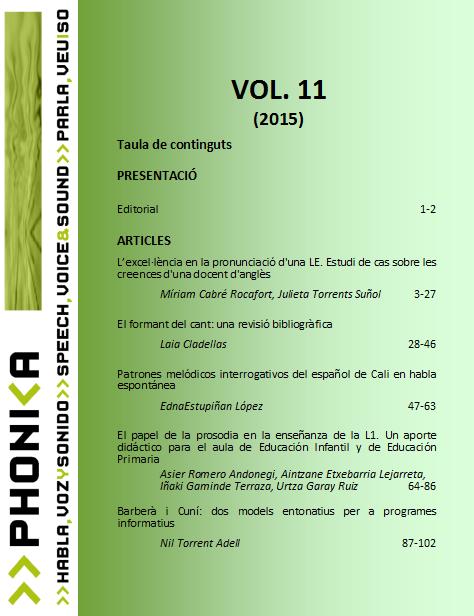The Formant of Song: A Bibliographic Review
DOI:
https://doi.org/10.1344/phonica.2015.11.28-46Keywords:
Singing voice, Sing formant, Voice quality, AcousticsAbstract
Singing is the use of the voice as a musical instrument. The characterization of lyrical singing voice is often ambiguous and abstract, but there is a general consensus on the fact that can differentiate a lyrical voice from other singing voices. One of the acoustic parameters of the lyrical voices is called "singing formant". Researchers have conducted studies to corroborate or not the presence of singing formant in the lyrical voices. This article provides a general review.References
Abad Royo, JM.; Abad Marco, A.; Tísner Giraldo, B.; Pérez Sámchez, A. & Chamizo García, JJ. (2003) Trabajo de investigación y clínica aplicada. “Análisis digital de la voz. Conceptos básicos”. O. R. L. Aragón 2003’; 6 (2) 13-19.
Bartholomew, W. T. (1934): “A physical definition of good “voice quality” in the male voice,” J. Acoust. Soc. Am., 1, 24-33.
Bloothooft, G. & R. Plomp (1984): “Spectral analysis of sung vowels. I. Variation due to differences between vowels, singers and models of singing”, Journal of Acoustical Society of America, 75 (4).
Bloothooft, G. & R. Plomp (1985): “Spectral analysis of sung vowels. II. The effect of fundamental frequency on vowel spectra”, Journal of Acoustical Society of America, 77 (4).
Bloothooft, G. & R. Plomp (1986): “Spectral analysis of sung vowels. III. Characteristics of singers and models of singing”, Journal of Acoustical Society of America, 79 (3).Bretos, J & Sundberg, J. (2003): “Measurements of Vibrato Parameters in Long Sustained Crescendo Notes as Sung by Ten Sopranos”. Journal of Voice, Vol. 17, No. 3, pp. 343-352.
Cantero Serena, F. J. (2003): “Fonética y didàctica de la pronunciación”, en Mendoza, A. (coord): Didáctica de la lengua y la literatura. Madrid: Prentice Hall.Cantero Serena, F. J. (2004): “Comunicació i veu”, a Articles de didàctica de la llengua i la literatura, num. 32. (Monografia: veu i locució).
Detweiler, RF. (1994). An investigation of the laryngeal system as the resonance source of the singer’s formant. Journal of Voice, 8(4), 303-313.
Elgström, E. (2006): “Fonetometria: una proposta de protocol”, Phonica, vol. 2.
Fant, G. (1960): Acoustic Theory of Speech Production. The Hague: Mouton.García-Tapia, R. & Cobeta, I (1996): Diagnóstico y tratamiento de los trastornos de la voz. Editorial Garsi, S.A. Madrid.
González, J.; Cervera, T. & J.L. Miralles (202): “Análisis acústico de la voz: fiabilidad de un conjunto de parámetros multidimensionales”, Acta Otorrinolaringológica, 53 (256-268).
Hines, J. (1990). Great singers on great singing. New York: 5th Limelight Edition.
Hirano, M. (1981): Clinical Examination of Voice. Springer-Verlag Wien. New York.
Kenny, D. T. & Mitchell, H. F. (2006): “Acoustic and Perceptual Appraisal of Vocal Gestures in the Female Classical Voice”. Journal of Voice, Vol. 20, No. 1, pp. 55-70.Laver, J. (1980): The phonetic description of voice quality. Cambridge University Press. Great Britain.
Lindqvist, J. (1970): "The voice source studied by means of inverse
filtering", STL-QPSR 1/1970
Omori, K; Kojima, H.; Kakani, R.; Slavit, DH. & Blaugrun, SM. (1997): “Acoustic characteristics of rough voice: Subharmonics.” Journal of Voice, 11: 40-47
Rontal, E.; Rontal, M. & Rolnick, M. I (1975): “Objective Evaluation of vocal pathology using voice spectrography”. Annals of Otology, Rhinology and Laryngology. 84.
Sengupta, R. (1990). “Study on some aspects of the “Singer’s Formant” in north Indian classical singing”. Journal of Voice, 4 (2), 129-134.
Sundberg, J. (1970). “Formant structure and articulation of spoken and sung vowels”. Folia Phoniatr., 22, 28-48.
Sundberg, J. (1972): “Articulatory interpretation of the ‘singer’s formant’ ”. J Acoust Soc Am., 55, 834-844.
Sundberg, J. (1973). “The source spectrum in professional singing”. Folia Phoniatr., 25, 71-90.
Sundberg, J. (1977). “The acoustics of singing voice”. Scientific American, 236 (3), 82-84, 86, 88-91.
Sundberg, J. (1987): The science of the singing voice. Northern Illinois University Press. Dekalb, Illinois.
Sundberg, J. (2001): “Level and Center Frequency of the Singer’s Formant”. Journal of Voice, Vol15. No. 2, pp. 176-186.
Titze, I.R. & Story B. H. (1997). “Acoustic interactions of the voice source with the lower vocal tract”. J Acoust Soc Am., 101(4), 2234-2243.
Vennard, W. (1967). Singing: the Mechanism and the Technique. New York: Carl Fischer Inc.
Wang, S. (1985). “Singing voice: Bright timbre, singer’s formants and larynx positions”. SMAC83 Conference Proceedings, Stockholm, 1, 31-322.
Weiss, R., Brown, W.S Jr. & Morris, J (2001): “Singer’s Formant in Sopranos: Fact or Fiction?” Journal of Voice, Vol. 15, No. 4, pp. 457-468.
Downloads
Published
Issue
Section
License
The author(s) publishing in this journal agree to the following terms:
- The author(s) retains the copyright and grants the journal the right to the first publication of the work.
- All contents included in PHONICA are subject to the Creative Commons Attribution 4.0 International License, which allows the work to be shared with third parties, provided that they acknowledge its authorship, initial publication in this journal and the terms of the license.



